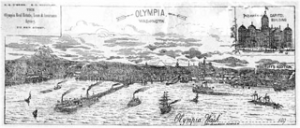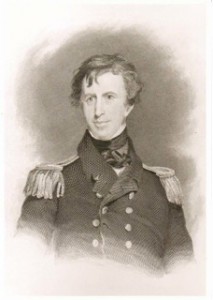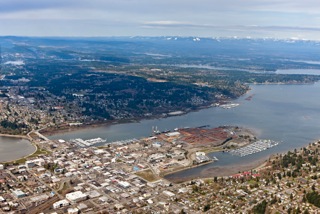By Drew Crooks

Place names often reflect the history of a region. One good local example is Budd Inlet, the name for the southernmost extension of Puget Sound. This inlet at the doorstep of Olympia is about seven miles long and one to two miles wide. The body of water has played a key role in the history of the Capital City from its settlement in 1850 to the present day.
The name of Budd Inlet is directly related to an interesting episode in our history, the mid-19th century U.S. Exploring Expedition. Oftentimes this maritime venture has been called the Wilkes Expedition after its commander Charles Wilkes. The American sailors and scientists in the government expedition, like other explorers, brought many new names to places they investigated. The South Puget Sound region was no exception.
From 1838 to 1842 the U.S. Exploring Expedition circled the globe mapping lands they encountered and showing the American flag. Civilian scientists, nicknamed the “Scientifics,” carried out studies in biology, botany, geology, languages, and anthropology. The expedition was very successful in charting little known lands and gathering information about their inhabitants.

In May 1841 Charles Wilkes and his men came to South Puget Sound. Using the Fort Nisqually area (where the city of DuPont is now) as a base, the expedition surveyed the shoreline and sent overland parties out to explore much of what later became Washington State. At the time both Great Britain and the United States claimed the Pacific Northwest. One result of the Wilkes Expedition was a strengthening of American interest in the region. Indeed, in 1846 the United States acquired by treaty with the British the land south of the 49th degree parallel.
Wilkes gave a number of names to South Puget Sound localities. In present-day Thurston County, for example, he named Cooper Point (originally Point Cooper) after John Cooper, who served as an armorer in the U.S. Exploring Expedition. The naval commander also labeled Eld Inlet after midshipman Henry Eld and Henderson Inlet after quartermaster James Henderson. In the last two cases, local names have come into use. Henderson Inlet is sometimes referred to as South Bay, and the southwest part of Eld Inlet is called Mud Bay.
In regards to Budd Inlet, Charles Wilkes of the U.S. Exploring Expedition named this body of water after Thomas A. Budd. This individual joined the Navy, and rose in the ranks from Midshipman (February 1829) to Passed Midshipman (July 1835) to Lieutenant (September 1841). Budd served for a time during the Wilkes Expedition as the acting master of the Peacock (a sloop of war), then transferred to the Vicennes (another sloop of war) at Fiji in the South Pacific. It is apparent from surviving accounts that he made a significant contribution to the exploring work of the expedition.
Consequently, it is no surprise that Charles Wilkes named several places mapped by the expedition after Thomas A. Budd. Part of Antarctica’s shoreline, between the Hatch Islands and Cape Waldron, was called Budd Coast by the Navy commander. In the Pacific Northwest Wilkes gave the name of Budd’s Harbor to a bay in the northeast corner of the Olympic Peninsula. This name, unlike Budd Coast, did not stick. The body of water is now known as Sequim Bay. Then, of course, Wilkes left in South Puget Sound the enduring place name of Budd Inlet.
What happened to Thomas A. Budd after the U.S. Exploring Expedition? He remained in the U.S. Navy, and for a time served on Pacific Coast mail steamers. A Daily Alta California (San Francisco) newspaper on January 4, 1850 noted that “Capt. Budd, the commander of the California, is probably the most popular of the officers of the Pacific steamship line. All who have ever taken at trip upon his vessel speak in the highest terms of his courtesy, urbanity and gentlemanly bearing and his qualities as a sailor.” Then in 1853 Budd resigned from the Navy in order to seek private opportunities.
The outbreak of the American Civil War in 1861 brought Thomas A. Budd back to the U.S. Navy. He reenlisted and was appointed an acting lieutenant. Given the command of the gunboat Penguin, Budd was killed in action during a skirmish on March 23, 1862 at Mosquito Inlet, Florida. A pension was later granted to his widow, Louisa T. Budd.
Still the name of Budd Inlet lives on. Though the local name of Olympia Harbor is sometimes used, Budd Inlet remains the official nomenclature for this important waterway. It seems appropriate to remember the man behind the name, the dedicated Navy officer Thomas A. Budd who gave his life for his country in the Civil War.
Further Reading
Barkan, Frances B., edited, The Wilkes Expedition: Puget Sound and the Oregon Country (Olympia, WA: Washington State Capital Museum, 1987).
Viola, Herman J. and Carolyn Margolis, edited, Magnificent Voyagers: The U.S. ExploringExpedition, 1838-1842 (Washington, D.C.: Smithsonian Institution Press, 1985).

















































